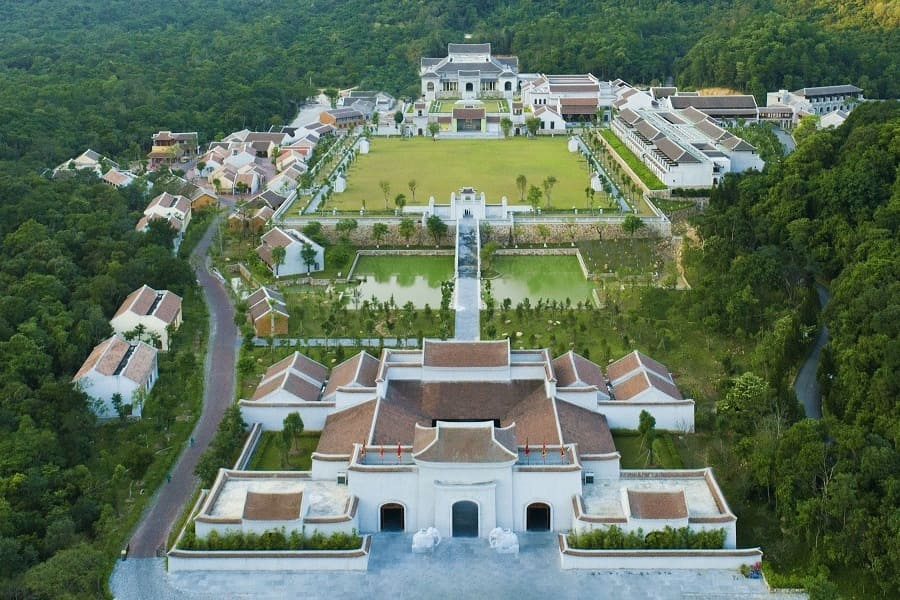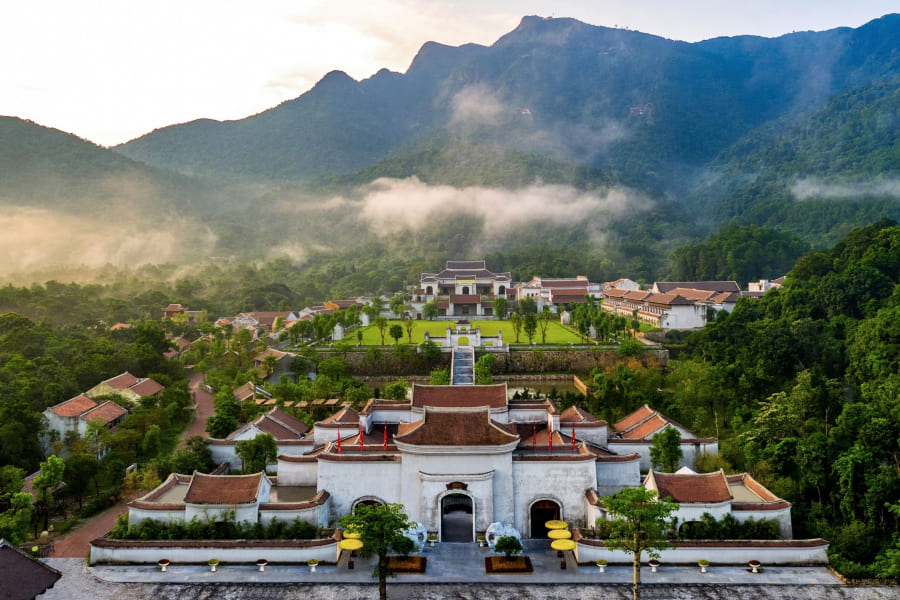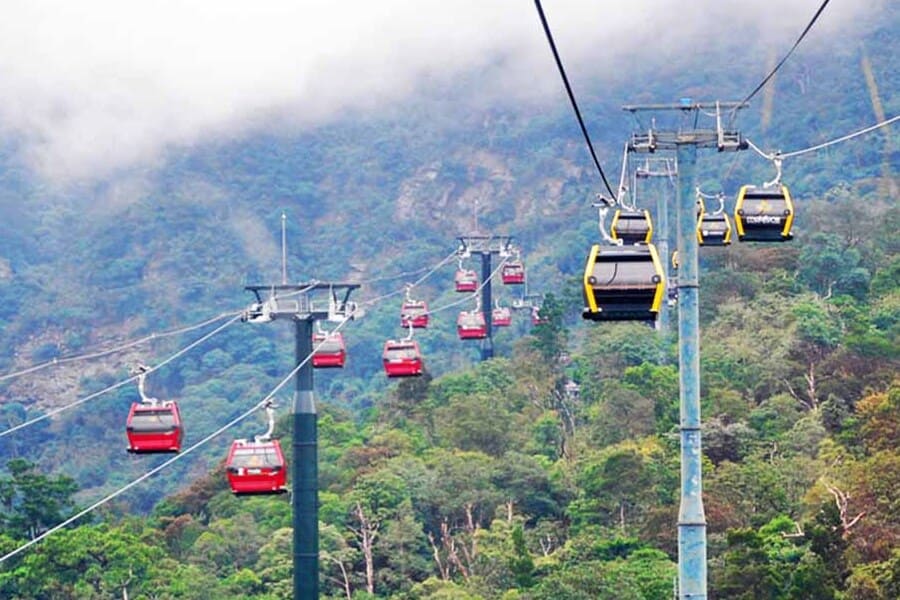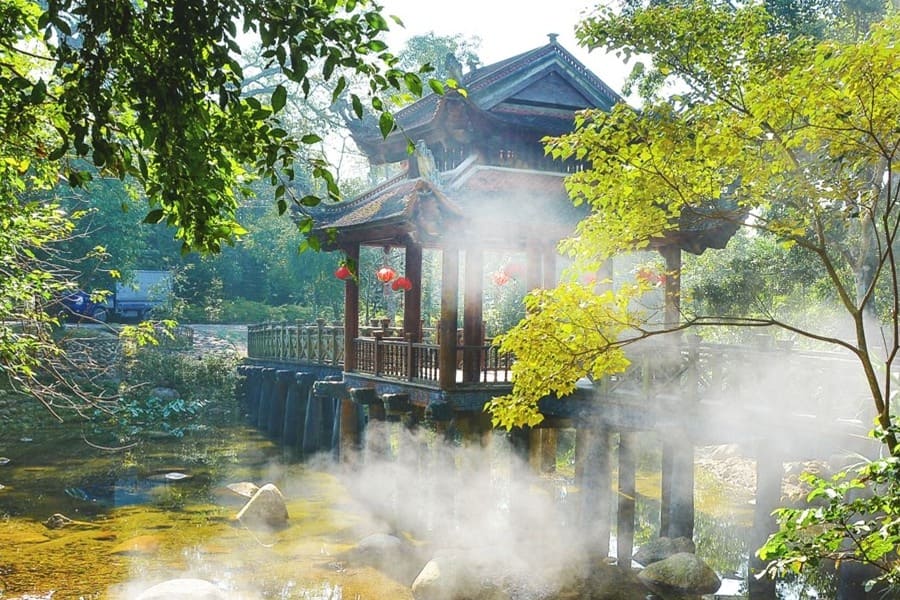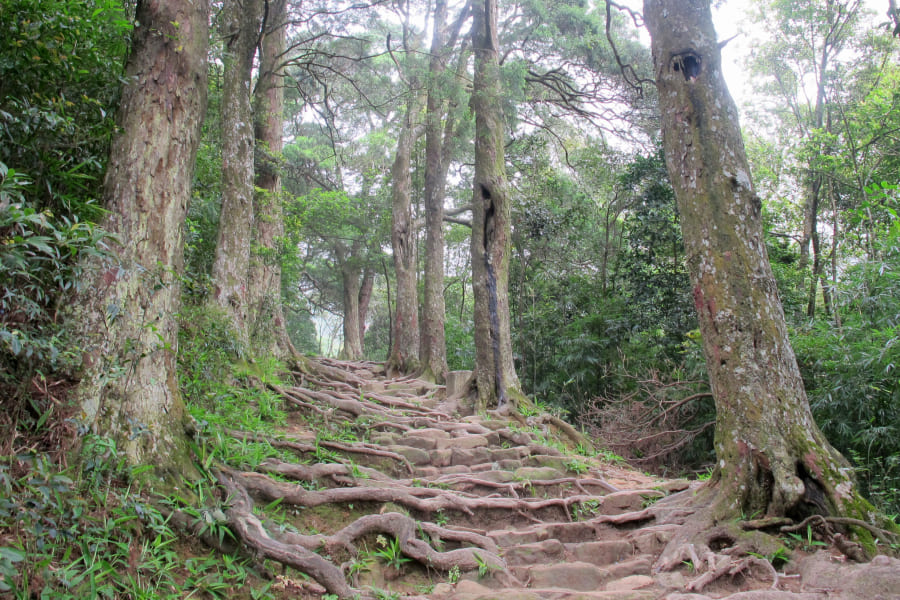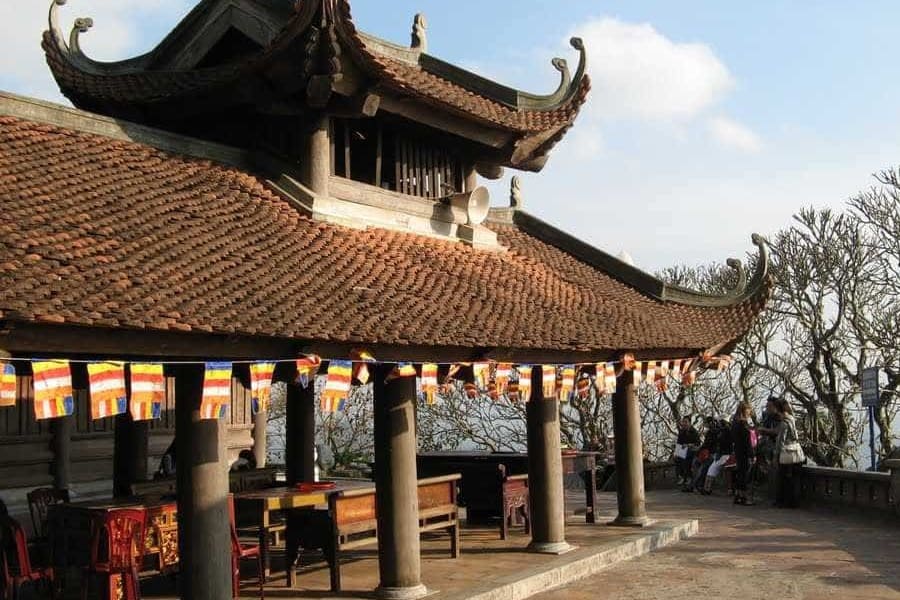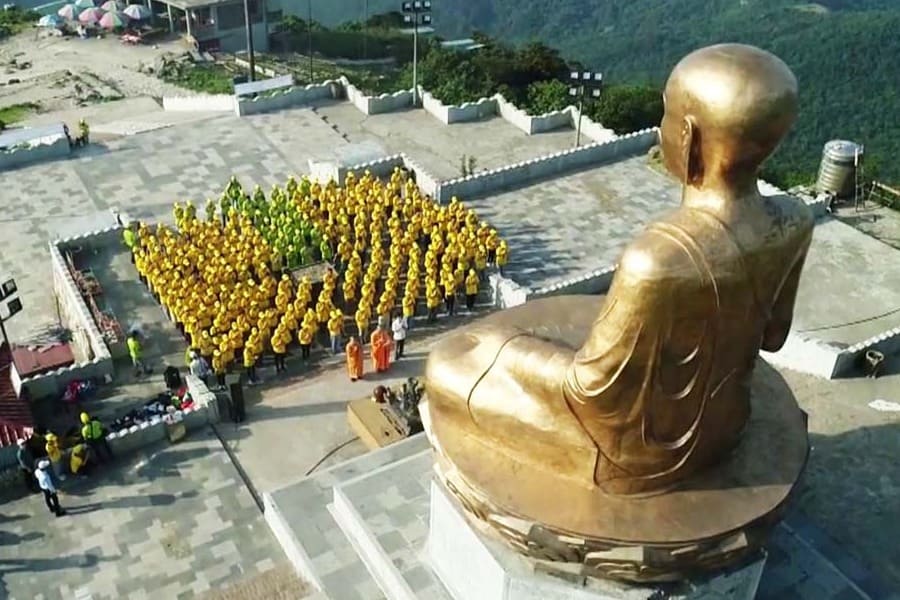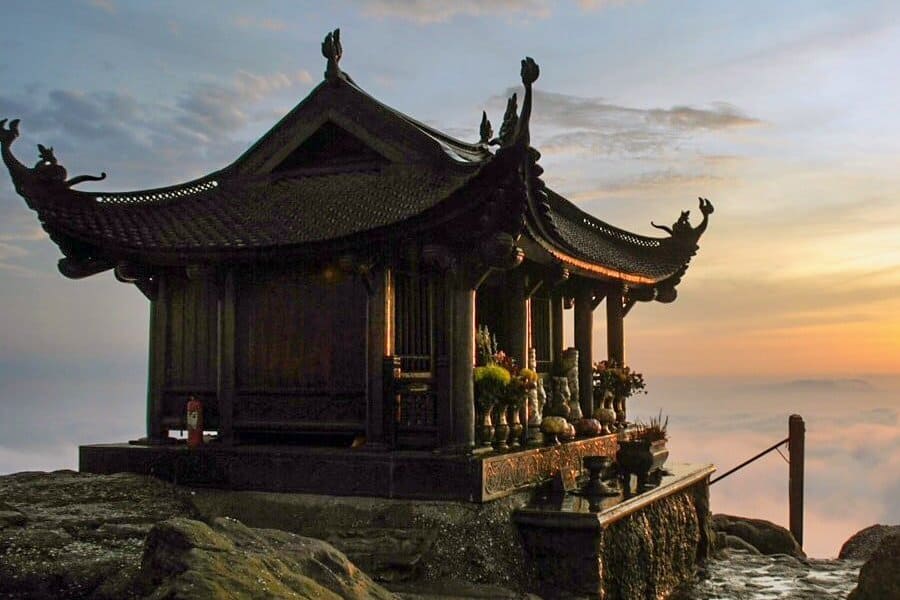Yen Tu is a famous Buddhist land with the Yen Tu tourist area showcasing poetic beauty and a system of pagodas with unique ancient architecture, attracting tourists from all over. Nestled amidst the grandeur of mountainous landscapes, the Yen Tu complex of relics exudes a serene ancient charm deeply intertwined with the history and growth of Vietnam’s Truc Lam Zen sect.
For those seeking a spiritual journey, Yen Tu tourism stands as the ideal destination. Each year, the Yen Tu festival spans from January 10th to the conclusion of the third lunar month, drawing visitors from far and wide. Additionally, visitors can easily combine their spiritual journey with Vietnam shore excursions, making the most of their travel experience in this culturally and naturally rich region.
Where Is Yen Tu Pagoda In Quang Ninh?
Yen Tu Pagoda in Quang Ninh is renowned as one of Vietnam’s most celebrated and beloved pagodas. Situated in Nam Mau village, Thuong Yen Cong commune, Uong Bi City, Quang Ninh Province, this site holds historical significance as the chosen place of practice for Emperor Tran Nhan Tong. It was here that he established the Truc Lam Yen Tu Zen Monastery, marking a pivotal moment in the development of Vietnamese Buddhism.
Yen Tu Pagoda, A Historical Perspective
After abdicating the throne to his son, Emperor Tran Nhan Tong chose to retreat to Yen Tu to engage in spiritual practice and teach the monks and nuns who gathered to listen. During his time here, he established the Truc Lam Yen Tu Zen Monastery, rooted in Vietnamese cultural beliefs. Accompanying him were two disciples, Zen masters Phap Loa and Huyen Quang, who also played pivotal roles in the founding of this Zen sect.
Architecture Of Yen Tu Pagoda
The architecture of Truc Lam Yen Tu’s temples and pagodas is revered as a faithful reconstruction of traditional Buddhist design. Visitors are captivated by the ancient appearance and serene ambiance:
Standing proudly atop stone steps, the majestic porch with its asymmetrical roof leads into the main courtyard paved with red bricks. Traditionally featuring three entrances and eight roofs, Yen Tu Pagoda faithfully adheres to this classic porch design.
Despite undergoing multiple renovations, Yen Tu pagodas retain their deep-rooted Buddhist and Vietnamese cultural values. Constructed from prestigious materials like bronze and ironwood, renowned for their exceptional durability, the pagoda’s entire pillar system is crafted from precious ironwood, while the veranda pillars are hewn from stone with a stone base beneath each.
The presence of stones beneath the pillars holds significant symbolism in Vietnamese religious architecture. In local folklore, a stone pillar supporting a wooden pillar symbolizes prosperity: the stone represents masculine life energy, while the wooden pillar embodies feminine life energy. This symbolism reflects the Vietnamese desire for abundance and tranquility, alongside aspirations for the continuity of life. Thus, Vietnamese pilgrims flock to Yen Tu Pagoda to pray for happiness, peace, and familial well-being.
Externally solemn and grand, the interior of the pagoda offers a cozy and serene atmosphere. Wooden planks surround the main hall, adorned with intricately carved doors to maintain a spacious and illuminated ambiance. Architects and engineers meticulously oriented the halls to optimize regional weather conditions, integrating natural ventilation through strategically placed windows and openings.
While some newer temples employ modern materials, they remain faithful to Buddhist architectural principles. Gilded embellishments, intricate carvings, and ornate altar decorations grace the interior, complementing revered statues like the Buddha at the Three Jewels throne, La Han statues in La Han Duong, and the seated Thich Ca Buddha in the main hall.
Inside the pagoda, a tranquil aroma pervades, soothing visitors and offering respite from the outside world. It is a space that instills a sense of peace and serenity, inviting all to leave behind the hustle and bustle of daily life.
Best Time To Visit Yen Tu Pagoda
Missing the period from the 10th day of the first lunar month to the third lunar month each year means missing out on the peak tourist season at Yen Tu Pagoda. During this time, the pagoda attracts numerous visitors from across the provinces who come for spring vacations and pilgrimages. The festival’s opening day transforms the sacred Buddhist site with vibrant traditional cultural and artistic activities, including the solemn “Sacred Seal of Bronze Pagoda” ceremony, incense offerings to Buddha, and homage to the Truc Lam Patriarch.
When you arrive at Yen Tu Pagoda and embark on a pilgrimage to the summit of Dong Pagoda, surrounded by majestic nature enveloped in clouds, you’ll experience a sensation akin to stepping into a fairyland. It feels as though the worldly concerns are brushed away, leaving your mind free from anger and ignorance. The Yen Tu Spring Festival offers a chance to immerse yourself in the serene and sacred atmosphere of Buddha’s realm
How To Get To Yen Tu Pagoda?
Cable car
Cable car to Yen Tu When coming to Yen Tu, you can conquer the sacred mountain in two ways: walking or cable car depending on the needs and health conditions of yourself and your companions. Note that the journey to climb Yen Tu is relatively tiring and requires good health, so if you are traveling with a family with the elderly and children, you should choose the cable car option to both ensure health and peace of mind to admire the beautiful scenery. Northeast mountains and forests.
Hiking
For those with the health and time to explore the wonders of Yen Tu Mountain, a 6km trek under the bamboo canopy and pine forest is an ideal choice. Recently, the pathway has been upgraded with reinforced stairs, enhancing ease and convenience for hikers.
Exploring The Yen Tu Pagodas
Giai Oan Pagoda & Giai Oan Stream
In your quest to visit Yen Tu Pagoda, you’ve likely heard of Giai Oan Pagoda & Giai Oan Stream. The path leading to Giai Oan Stream features a 10-meter-long blue stone bridge adorned with ancient hues, spanning over a crystal-clear stream. According to legend, this stream served as a place of exoneration and salvation for concubines and beauties from the Tran Dynasty. They chose to end their lives here after failing to persuade their king to return to the court.
Giai Oan Pagoda, also known as Ha Pagoda, stands prominently along your journey to conquer Yen Tu, situated near Trinh Pagoda, Dong Pagoda, Trung Pagoda, and Hoa Yen Pagoda. Upon reaching the temple gate, you’ll encounter six towers, including the resting places of monks Phap Loa and Huyen Quang, along with a tower dedicated to King Tran Nhan Tong.
Tung Street
Continuing on the path towards enlightenment, the journey to Yen Tu Pagoda takes you through the ancient Tung Street, which boasts a history spanning over 700 years. This historic road is flanked by more than 250 ancient pine trees, their robust trunks so large that they cannot be embraced by a single person. These majestic pine trees imbibe the sacred essence of the ancestral land, remaining evergreen and stretching magnificently towards the sacred mountain.
These towering pines provide shelter and respite for pilgrims, monks, nuns, and Buddhists alike, creating a serene atmosphere ideal for exploring the roots of Buddhism in a tranquil and pleasant setting.
Hoa Yen Pagoda
Hoa Yen Pagoda, also known as Ca Pagoda, sits majestically at an elevation of 534 meters, serving as the largest and most revered pagoda in Yen Tu. It holds a central place in the hearts of those embarking on a journey to Yen Tu Pagoda, representing a pivotal destination in their pilgrimage. Originally established during the Ly Dynasty under the name Phu Van, the pagoda underwent name changes throughout history, finally becoming known as Hoa Yen Pagoda during the Le Dynasty.
This exquisitely beautiful pagoda atop Yen Tu mountain once served as a sacred site where the Buddha imparted teachings to monks, nuns, and Buddhists. After ascending thousands of stone steps, visitors reach Hoa Yen Pagoda to marvel at its architecture, which reflects the intricate and elaborate style of the Tran Dynasty. Additionally, nearby stands the Hue Quang To Tower, where relics associated with King Tran Nhan Tong are preserved, adding further historical and spiritual significance to the pilgrimage experience.
Statue Of Buddha Emperor Tran Nhan Tong & An Ky Sinh
Continuing your journey to conquer the experience of going to Yen Tu pagoda, you will see the majestic and decorated statue of Buddha Emperor Tran Nhan Tong built on top of An Ky Sinh peak. The statue weighs up to 138 tons, is 15 m high, and is located in the middle of Yen Tu paradise, extremely eye-catching. Next to the statue of Buddha Emperor Tran Nhan Tong is a statue of a petrified monk (An Ky Sinh) tinged with time, moss, and full of nostalgia. Wearing a dark robe, with both hands respectfully in front of his chest, the statue stands tall and majestic, having experienced 7 decades of many weather impacts in the middle of sacred mountains, and at the same time contains profound meanings that no one can see. it is difficult to become enlightened
Bao Sai Pagoda
Bao Sai Pagoda is the next coordinate when looking for experiences to go to Yen Tu Pagoda. This pagoda named after the first disciple of Buddha Emperor Tran Nhan Tong – Zen Master Bao Sai is located on Yen Tu cliff. After many restorations, Bao Sai Pagoda still retains the intact architecture of the Tran Dynasty at the Patriarch’s house, the main hall as well as its sacred and unique landscape. In particular, Bao Sai Pagoda also has a god altar and an ancient moss-covered sacred well. Along with that is the huge, huge statue of Buddha Emperor Tran Nhan Tong entering Nirvana, extremely eye-catching.
Useful Tips When Visiting Yen Tu Pagoda
- For an ideal visit to Yen Tu, plan for a day and night stay, or opt for a day trip.
- Expect bustling crowds during the Yen Tu festival for a vibrant experience. Weekdays offer a quieter and more serene atmosphere.
- If hiking up Yen Tu mountain, wear sturdy sports or hiking shoes, and dress appropriately for the weather with lightweight clothing. Carry a compact backpack for snacks, water, and personal items. Due to limited ATM access and potential for pickpocketing, bring sufficient cash.
- Purchase a bamboo cane at the mountain base (costing 5,000 VNĐ) for added stability and stamina during the ascent to the summit. Capture memorable moments with a camera or phone along the way.
- Transport options include buses or private cars. Buses depart primarily from Luong Yen and My Dinh stations. For private vehicles, ensure to plan your route meticulously and pack essentials.
- Respectful attire is essential at Yen Tu Pagoda, a sacred site. Maintain proper decorum, refrain from littering, and preserve the natural surroundings.
- If feeling fatigued during the journey, take breaks to rest, hydrate, and rejuvenate before continuing.
Yen Tu Pagoda offers a sacred and tranquil setting, especially during the early days of the new year. I hope these tips assist you, your family, and friends on your upcoming visit. Exploring Yen Tu in Halong Bay shore excursions is not just a pilgrimage; it’s an ideal spring excursion for all, whether with loved ones or colleagues, as the New Year begins.

